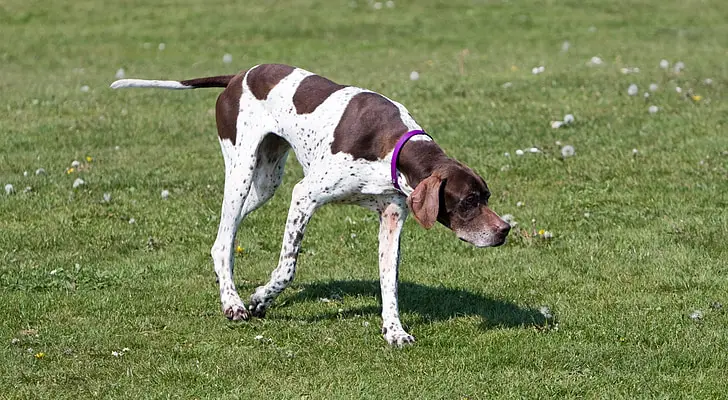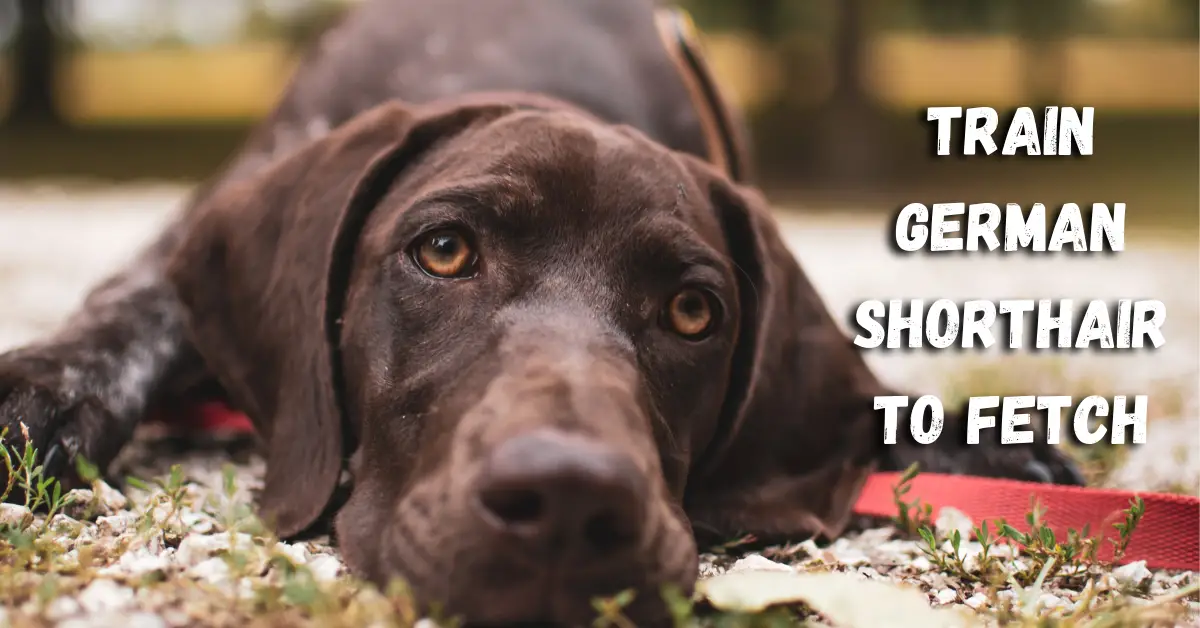Do you imagine throwing a ball and having your dog bring it back with a wagging tail but often struggle to make it happen? While fetch comes naturally to most German Shorthairs, it may not be the same for every dog.
Every dog parent desires to play this game with their pooch, and it can be discouraging to see other parents enjoy it with their dog. But don’t lose hope! With some patience and tricks up your sleeve, you and your dog can become the best fetch pals.
Read our guide to learn how to train German Shorthair Pointers to fetch.

What Do You Need
- A ball or toy
- A yarn or rope
- Small pieces of dog treats
- An enclosed area
- 15-20 minutes per day
Preparing Your German Shorthair
Before you begin training your Shorthair to fetch, there are a few things you need to do to get them ready.
Choose The Right Toy
Picking the right toy is an important part of dog fetch training, which many people may neglect. When choosing a toy, it’s necessary to consider the age, size, and playing habits of your dog. If you have a young pup, select a small toy that is soft to hold with its teeth, whereas if you have an adult dog, you can opt for strong toys.
There are a variety of toys you can choose from, such as balls, retrieve bumpers, soft discs, rope toys, and plushies. You can try different toys to determine which ones your dog prefers the most. Once your dog picks its favorite toys, you can keep 2-3 of them and start training.
Find a Safe Space
In the initial stages of training, it is best to stay in an enclosed area like a hallway, bedroom, or backyard. A small room will remove extra distractions and help your dog focus on you and the task at hand.
Dogs tend to run with the toy anywhere but to the original spot. With limited space, your dog will not have any place to run to, and it will most likely bring the toy back to you.
Teach Basic Hand And Voice Commands
For any type of training, it is essential to introduce your dog to some basic voice and hand gestures. Similarly, for fetch training, commands like “come,” “fetch,” “bring it,” “hold,” and “drop it” are a must.
Call out your dog by its name, followed by the “come” command and even some whistles. Gradually increase the distance between you and your dog as it gets better at following the command.
You can teach your dog the “fetch” command by throwing a toy at a close distance while pointing towards the toy. If your dog is not interested in the toy, try it with a treat, dogs can never refuse treats!
Ask your dog to get the toy or any other object by saying “bring” and use tapping gestures on the floor to let it come to you.
When your dog has the toy in its mouth, keep your hand below its mouth and ask it to “drop it.” Do not pull the toy out from the mouth and wait for it to do so. When your dog eventually does that, praise and reward it.
Familiarize It With The Toy
Once your dog learns the basic commands, it will be easier for you to train it. But before you begin teaching it to fetch, you must allow it to get comfortable with the toy. Start by sitting on the floor with your dog and playing, bouncing, and rolling the toy to get its attention.
Put the toy next to you, let your dog sniff it, and put it in its mouth. If it seems interested in the toy, encourage it to keep it in its mouth for longer durations. Ask your dog to “hold” it in the mouth until you give the signal.
When the toy becomes your dog’s favorite plaything, try keeping it at a farther distance in the same room and observe them. Persuade it to pick up the toy (by throwing a few treats), holding it in the mouth, and then dropping it. It is far better to have many short repetitions than fewer long shots.
Method For Fetch Training
There are different methods of training a German Shorthair to fetch. You can try all these methods and choose one that works best for your pup.
Reward Based Method
This is one of the most common and successful methods for teaching a German Shorthair to fetch. When your dog has become familiar with picking the toy in an enclosed area, you can start playing fetch with it by gradually increasing the distance.
The aim is to shower your dog with love, treats, and playtime, and by combining these motivating factors, get it to complete the task. Go to your backyard or a park and throw the object at about a 10 feet distance. Since Shorthairs have the instinct to run after a thrown object, they will chase the toy.
The next step is to make it return the item to you. This is the tricky part where you have to use its favorite treat to lure it towards you. Motivate your pup to return with the toy; if it does not, use the “bring” command and reward it. Practice this daily for a few minutes until your dog learns the deal.
Bait And Switch Method

This method is excellent for your dog if it loves to chase toys but gets distracted when bringing them back. Keep two of its most beloved toys in hand and toss the first one.
Watch your dog as it runs after the first toy and then use the second toy as bait. It will get excited to see a new toy and may quickly come back to you with the first toy. However, if it goes a little overboard and drops the first toy while returning, throw the second toy in another direction.
Quickly retrieve the first toy as it goes for the second one and come to your original position. Repeat this pattern of tossing one toy and using the second one as bait several times. Eventually, your dog will start to understand the rules and bring one toy back to you, eager to chase the other one.
Stringing The Ball Method
Take a tennis ball and make two holes in it on each side. Insert a yarn through these holes and make a tight knot. Let the ball attached to the string sit on the ground and wait for your dog to see it. Now gently pull the rope until it starts following the ball.
Do this trick back and forth so that your dog begins to enjoy the game. Slowly increase the difficulty level of the game by running alongside your dog while using cheerful words to motivate it.
Additional Tips
- Always throw the toy in your dog’s line of sight to grab the most attention.
- Hold your dog back and make him wait to pique curiosity.
- Find toys with compartments where you can put treats.
- Stop the practice before it gets tired to maintain the excitement for the next day.
Conclusion
Training your German Shorthair to fetch can not only be a fun activity for your dog but for you as well. Playing fetch together will establish trust and communication between you two and also improve your dog’s skills.
Remember that it is supposed to be an enjoyable experience, so you must not scold or push your dog. Have patience and lots of treats, and soon you will see your dog nagging you to play fetch with them.


